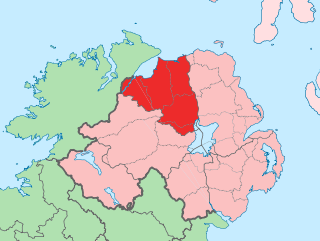
County Londonderry, also known as County Derry, is one of the six counties of Northern Ireland, one of the thirty two counties of Ireland and one of the nine counties of Ulster. Before the partition of Ireland, it was one of the counties of the Kingdom of Ireland from 1613 onward and then of the United Kingdom after the Acts of Union 1800. Adjoining the north-west shore of Lough Neagh, the county covers an area of 2,118 km2 (818 sq mi) and today has a population of about 247,132.

Maghera is a small town at the foot of the Glenshane Pass in County Londonderry, Northern Ireland. Its population was 4,220 in the 2011 Census, increasing from 3,711 in the 2001 Census. It is situated within Mid-Ulster District, as well as the civil parish of Maghera, which it was named after, and the former barony of Loughinsholin.
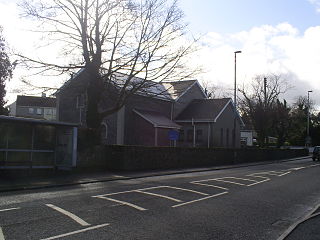
Newbuildings or New Buildings is a large village in County Londonderry, Northern Ireland. It lies close to the banks of the River Foyle and 3 mi (5 km) south of the city of Derry. It had a population of 3,381 in the 2011 Census. It is within Derry and Strabane district.

Glynn is a small village and civil parish in the Mid and East Antrim Borough Council area of County Antrim, Northern Ireland. It lies a short distance south of Larne, on the shore of Larne Lough. Glynn had a population of 2,027 people in the 2011 Census.
Ballynagalliagh is a townland in County Londonderry, Northern Ireland. It lies within Derry and Strabane district.
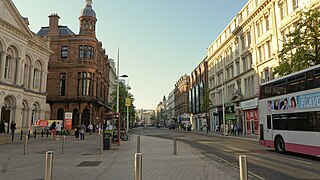
The economy of Northern Ireland is the smallest of the four constituents of the United Kingdom and the smaller of the two jurisdictions on the island of Ireland. At the time of the Partition of Ireland in 1922, and for a period afterwards, Northern Ireland had a predominantly industrial economy, most notably in shipbuilding, rope manufacture and textiles, but most heavy industry has since been replaced by services. Northern Ireland's economy has strong links to the economies of the Republic of Ireland and Great Britain.
Shantallow is a townland in County Londonderry, Northern Ireland. It is now part of the city of Derry, and is situated within Derry and Strabane district. It lies within the civil parish of Templemore and former barony of North-West Liberties of Londonderry. The townland is no longer a visible feature of Derry, being mainly built over with 20th-century housing estates.

Garvagh is a village in County Londonderry, Northern Ireland. It is on the banks of the Agivey River, 18 kilometres (11 mi) south of Coleraine on the A29 route. In the 2001 Census it had a population of 1,288. It is situated within Causeway Coast and Glens district.
Lettershandoney or Lettershendony is a small village and townland in County Londonderry, Northern Ireland, six miles to the southeast of Derry and three miles east of Drumahoe. In the 2001 census it had a population of 506 people. It is situated within Derry and Strabane district.
Strathfoyle is a village in County Londonderry, Northern Ireland It is about 5 miles (8.0 km) north east of Derry. It was newly built in different phases between the late 1950s and the early 1960s, with many new recent additions to the village, including Westlake, Butler's Wharf and Old Fort. In the 2001 Census it had a population of 1,581 people. It is within the Derry Urban Area and the Derry City Council area. The village has a small retail outlet, a Roman Catholic chapel, a library, youth club and a post office. The small retail unit was constructed in 2005 following years of under-investment in the area and pressure by local community leaders to provide more facilities for its residents.
Campsey or Campsie is a small village in County Londonderry, Northern Ireland. In the 2001 Census it had a population of 195 people. It is near Derry city and within the Derry and Strabane district area.
Goshedan is a hamlet and townland in County Londonderry, Northern Ireland. In the 2001 Census it had a population of 90 people. It is situated within the Derry and Strabane district.

Knockloughrim or Knockcloghrim is a small village near Maghera in County Londonderry, Northern Ireland. In the 2001 Census it had a population of 186 people. Knockloughrim lies within the civil parish of Termoneeny and is part of the former barony of Loughinsholin. It is situated within the Mid Ulster District Council area.
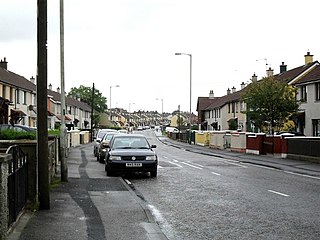
Creggan is a large housing estate in Derry, Northern Ireland, on a hill not far from the river Foyle.
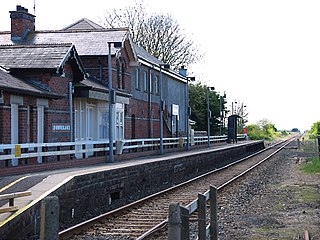
Bellarena (derived from French belle "beautiful" + Latin arena "sand, strand"; is a small village and townland in County Londonderry, Northern Ireland. It is on the A2 coastal road between Limavady and Coleraine, 6 miles north of Limavady. The land was settled in the mid-17th century by a Northamptonshire gentleman, William Gage, who bought the lease of the estate – then called Ballymargy from the Irish meaning "town of the market" – from the Lord Bishop of Derry. In the 2001 census the population was 291. The village lies within Causeway Coast and Glens District Council area and the Binevenagh Area of Outstanding Natural Beauty, with open views eastwards to the scarp slope of Binevenagh. The village gets its name from the Earl Bishop of Derry.
Events during the year 1968 in Northern Ireland.
The Northern Ireland Housing Executive is the public housing authority for Northern Ireland. It is Northern Ireland's largest social housing landlord, and the enforcing authority for those parts of housing orders that involve houses with multiple occupants, houses that are unfit, and housing conditions. The NIHE employed 2,865 persons as of 31 March 2020.
Boom Hall is a house and demesne in Derry, Northern Ireland. Lying close to the west bank of the River Foyle, a fort was constructed on the site during the English Civil War. During the Williamite War in Ireland a boom was constructed across the river to try to prevent Williamite forces relieving the Siege of Derry. A two-storey country house was subsequently built on the site by the Alexander family and named after this boom. The estate was later leased to a number of people until a leasehold was sold to Daniel Baird in 1849 by The 3rd Earl of Caledon. This was inherited by Daniel Baird Maturin-Baird who also purchased the freehold from the Alexanders. Boom Hall was again let to a number of different people, with Michael Henry McDevitt living there from 1924. During the Second World War, the demesne was used by the Admiralty and a number of temporary huts were built there. McDevitt purchased the freehold in 1949 and the house was renovated. It fell into disuse in the 1960s and was almost destroyed by fire in the 1970s. Part of the estate was used for the construction of the Foyle Bridge.










